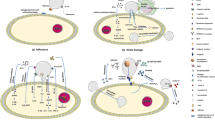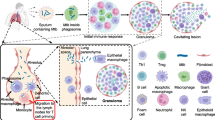Abstract
The catabolic metabolism ofHaemophilus parainfluenzae involves the activity of enzymes of the Embden-Meyerhof-Parnas pathway, the hexose monophosphate pathway, and the tricarboxylic acid cycles. The enzymes of these pathways are very likely localized in the cytoplasm of the bacteria and generate the catabolites which have an obligatory reaction with the membrane-bound electron transport system. The catabolites formed interact to reduce or in some cases to reoxidize six distinct primary membrane-bound dehydrogenases of the electron transport system. The obligatory interaction of the catabolic enzyme systems and the membrane-bound electron transport system involves the generation of DPN as beef heart lactic dehydrogenase can substitute for the membrane-bound electron transport system.
The utilization of glucose, the reoxidation of reduced pyridine nucleotide, and the growth ofH. parainfluenzae all depend on: 1. a functional electron transport system; and 2. suitable externally supplied electron acceptors. Studies with respiratory inhibitors indicate that the primary dehydrogenases, the quinone, the cytochromes and possibly the cytochrome oxidases are involved. An electron acceptor, either DPN, TPN, fumarate, pyruvate, nitrate or oxygen, must be present. Nitrate and oxygen reoxidize the reduced electron transport system by reoxidizing the cytochrome oxidases. There is preliminary evidence that fumarate, possibly TPN, and pyruvate cause pyridine nucleotide reoxidation by oxidizing the proper primary dehydrogenase.
Similar content being viewed by others
References
Alexander, H. E. 1958. TheHemophilus group. p. 470–485.In R. J. DuBos, (ed.), Bacterial and mycotic infections of man. 3rd ed. J. B. Lippincott Co., Philadelphia.
Barker, S. B. andSummerson, W. H. 1941. The colorimetric determination of lactic acid in biological material. J. Biol. Chem.138 535–554.
Bodansky, O. 1954. Serum phosphohexose isomerase in cancer, method of determination and establishment of range of normal values. Cancer7 1191–1199.
Bücher, T. andPfleiderer, G. 1955. Pyruvate kinase from muscle. p. 435–440.In S. P. Colowick and N. O. Kaplan, (ed.), Methods in enzymology, Vol. I. Academic Press, New York,
Cochrane, V. W. 1955. The metabolism of species of streptomyces. VIII. Reactions of the Embden-Meyerhof-Parnas sequence inStreptomyces coelicolor. J. Bacteriol.69 256–263.
Daron, H. H. andGunsalus, I. C. 1962. Citratase and isocitratase, p. 622–633.In S. P. Colowick and N. O. Kaplan, (ed.), Methods in enzymology, Vol. V. Academic Press, New York.
Gingrich, W. andSchlenk, F. 1944. Codehydrogenase I and other pyridinium compounds as V-factor forHemophilus influenzae andH. parainfluenzae. J. Bacteriol47 535–550.
Gornall, A. G., Bardawill, C.J. andDavid, M. M. 1949. Determination of serum proteins by means of the biuret reaction. J. Biol. Chem.177 751–766.
Henriksen, S. D. 1948. Pleomorphism inHemophilus hemolyticus caused by V-factor deficiency Acta Pathol. Microbiol. Scand.25 431–438.
Hill, R. L. andMills, R. C. 1954. The anaerobic glucose metabolism ofBacterium tularense. Arch. Biochem. Biophys.53 174–183.
Hu, A. S. L. andCline, A. L. 1964. Regulation of some sugar dehydrogenases in a pseudomonad. Biochim. Biophys. Acta93 237–245.
Klein, J. R. 1940. The oxidation ofl(−)-aspartic andl(+)-glutamic acids byHemophilus parainfluenzae. Note on the preparation of pyridine nucleotides from baker's yeast by the method of Warburg and Christian. J. Biol. Chem.134 43–57.
Kornberg, H. L. andMadsen, N. B. 1958. The metabolism of C2 compounds in micro-organisms. Biochem. J.68 549–557.
Krebs, H. A. 1950. Manometric determination ofl-aspartic acid andl-asparagine. Biochem. J.47 605–614.
Lester, R. L., White, D. C. andSmith, S. L. 1964. The 2-Desmethyl vitamin K2's. A new group of naphthoquinones isolated fromHemophilus parainfluenzae. Biochemistry3 949–954.
Massey, V. 1955. Fumarase. p. 729–735.In S. P. Colowick and N. O. Kaplan, (ed.), Methods in enzymology, Vol. I. Academic Press, New York.
Morrison, J. F. andPeters, R. A. 1954. Biochemistry of fluoroacetate poisoning: the effect of fluorocitrate on purified aconitase. Biochem. J.58 473–479.
Nelson, N. 1944. A photometric adaptation of the Somogyi method for the determination of glucose. J. Biol. Chem.153 375–380.
Ochoa, S. 1955. Malic dehydrogenase from pig heart. p. 735–739.In. S. P. Colowick and N. O. Kaplan, (ed.), Methods in enzymology, Vol. I. Academic Press, New York.
Segal, S., Blair, A. E. andWyngaarden, J. B. 1956. An enzymatic spectrophotometric method for the determination of pyruvic acid in blood. J. Lab. and Clin. Med.48 137–143.
Sibley, J. A. andLehninger, A. L. 1949. Determination of aldolase in animal tissues. J. Biol. Chem.177 859–872.
Somogyi, M. 1945. Determination of blood sugar. J. Biol. Chem.160 69–73.
Terner, C., Eggleston, L. V. andKrebs, H. A. 1950. The role of glutamic acid in the transport of potassium in brain and retina. Biochem. J.47 139–149.
Velick, S. F. 1955. Glyceraldehyde-3-phosphate dehydrogenase from muscle. p. 401–406.In S. P. Colowick and N. O. Kaplan, (ed.), Methods in enzymology, Vol. I. Academic Press, New York.
White, D. C. 1962. Cytochrome and catalase patterns during growth ofHaemophilus parainfluenzae. J. Bacteriol.83 851–859.
White, D. C. 1963a. Respiratory systems in the hemin-requiringHaemophilus species. J. Bacteriol.85 84–96.
White, D. C. 1963b. Factors affecting the affinity for oxygen of cytochrome oxidases inHemophilus parainfluenzae. J. Biol. Chem.238 3757–3761.
White, D. C. 1964. Differential synthesis of five primary electron transport dehydrogenases inHemophilus parainfluenzae. J. Biol. Chem.239 2055–2060.
White, D. C. 1965a. Synthesis of 2-demethyl vitamin K2 and the cytochrome system inHaemophilus. J. Bacteriol.89 299–305.
White, D. C. 1965b. The function of 2-demethyl vitamin K2 in the electron transport system ofHemophilus parainfluenzae. J. Biol. Chem.240 1387–1394.
White, D. C., Bryant, M. P. andCaldwell, D. R. 1962. Cytochrome-linked fermentation inBacteroides ruminicola. J. Bacteriol.84 822–828.
White, D. C. andSmith, L. 1962. Hematin enzymes ofHemophilus parainfluenzae. J. Biol. Chem.237 1332–1336.
White, D. C. andSmith, L. 1964. Localization of the enzymes that catalyze hydrogen and electron transport inHemophilus parainfluenzae and the nature of the respiratory chain system. J. Biol. Chem.239 3956–3963.
Wick, A. M., Drury, D. R., Nakada, H. I. andWolfe, J. B. 1957. Localization of the primary metabolic block produced by 2-deoxyglucose. J. Biol. Chem.224 963–969.
Wong, D. T. O. andAjl, S. J. 1955. Isocitritase inEscherichia coli. Nature176 970–971.
Author information
Authors and Affiliations
Rights and permissions
About this article
Cite this article
White, D.C. The obligatory involvement of the electron transport system in the catabolic metabolism ofHaemophilus parainfluenzae . Antonie van Leeuwenhoek 32, 139–158 (1966). https://doi.org/10.1007/BF02097454
Received:
Issue Date:
DOI: https://doi.org/10.1007/BF02097454




